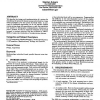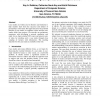1616 search results - page 185 / 324 » networks 2002 |
101
click to vote
SAC
2002
ACM
14 years 9 months ago
2002
ACM
We describe the design and implementation of a system for simulating the spread of disease among individuals in a large urban population over the course of several weeks. In contr...
SIGCSE
2002
ACM
14 years 9 months ago
2002
ACM
In this paper, we describe PortOS, an educational operating system designed to complement undergraduate and graduate level classes on operating systems. PortOS is a complete user-...
SIGCSE
2002
ACM
14 years 9 months ago
2002
ACM
A Beowulf cluster is a MIMD multiprocessor built from commodity off-the-shelf personal computers connected via a dedicated network, running free open-source software. Such a clust...
SIGCSE
2002
ACM
14 years 9 months ago
2002
ACM
Case studies are widely used in business and medicine to help students learn from the successes and failures of practitioners in the field. This paper discusses the potential bene...
TVLSI
2002
14 years 9 months ago
2002
: Clock networks account for a significant fraction of the power dissipation of a chip and are critical to performance. This paper presents theory and algorithms for building a low...


